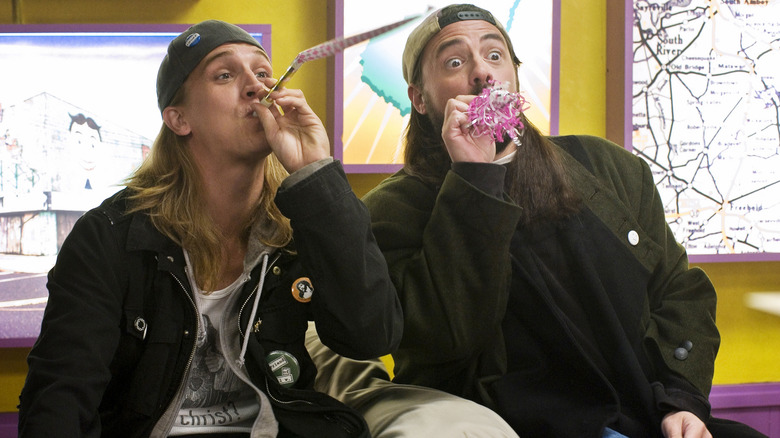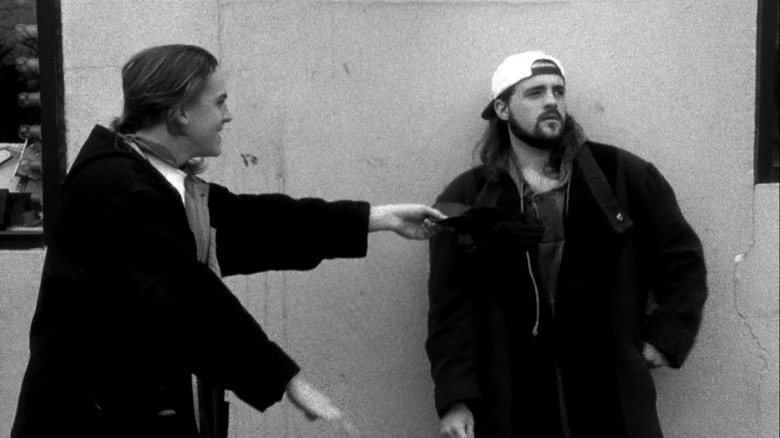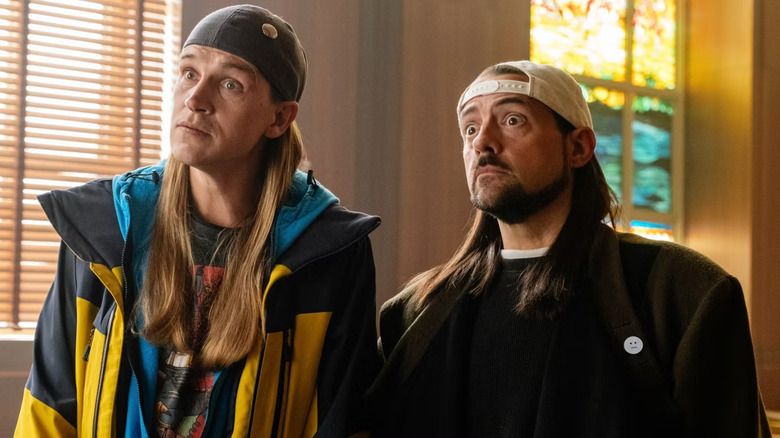The Correct Order To Watch The Jay And Silent Bob Movies
There was a time when Kevin Smith was regarded as being one of the definitive filmmakers of Generation X. His feature directing debut on the shoestring-budgeted 1994 indie hit "Clerks" suggested Smith not only had a firm understanding of the slacker mentality that afflicted so many people in his age bracket, but he was also shrewd enough to be critical of it. The film centers on disgruntled Quick Stop Groceries clerk Dante Hicks (Brian O'Halloran) and those in his immediate vicinity, including his equally-cynical, unmotivated best friend Randal Graves (Jeff Anderson) and the off-beat drug dealers that loiter outside the store: loud-mouthed horny miscreant Jay (Jason Mewes) and his reserved yet secretly wise companion Silent Bob (Smith). As colorful as these characters were, they also felt like real people you could imagine Smith knew growing up on his home turf of New Jersey.
At first, Smith retained this acerbic wit and deeply personal approach to his subsequent films, many of which included Jay and Silent Bob as supporting players. However, much like the characters themselves, the world they lived in — which would come to be known as the View Askewniverse — gradually became more and more outlandish. By the time Jay and Silent Bob started headlining their own movies, the series had ventured into full-blown stoner comedy territory (even turning the self-described hetero life-mates into literal cartoons at one point). In the years that followed, Smith would similarly abandon his caustic outlook towards his "Clerks" characters and become far more loving towards them, along the way evolving into more of a personality first and an artist second (much like his idol before him, Stan Lee).
It's worth keeping this in mind as you dive into the View Askewniverse, be it your first trip or a return after years away.
The Snoochie Boochies of the View Askewniverse
Fortunately, the View Askewniverse is pretty straightforward; just watch the films in the order of their release and you'll be fine. In other words:
- "Clerks" (1994)
- "Mallrats" (1995)
- "Chasing Amy" (1997)
- "Dogma" (1999)
- "Jay and Silent Bob Strike Back" (2001)
- "Clerks II" (2006)
- "Jay & Silent Bob's Super Groovy Cartoon Movie!" (2013)
- "Jay and Silent Bob Reboot" (2019)
- "Clerks III" (2022)
In a way, you could break these films down into three trilogies, much like the Skywalker Saga. No doubt Smith, an avowed "Star Wars" enthusiast, would approve of this comparison.
The first set — "Clerks," "Mallrats," and "Chasing Amy" — reflects Smith's early efforts to find his voice as a filmmaker. "Mallrats" is a more broadly comedic and otherwise commercial treatment of the themes and ideas from "Clerks," once again following a motley crew of go-nowhere Gen-X slackers, their fed-up girlfriends, and the weird customers that parade in and out of a shopping establishment, this time in the form of a mall. "Chasing Amy," on the other hand, finds Smith the artist working through his demons in the wake of his failed real-life relationship with the film's star, Joey Lauren Adams. Its humor is even more emotionally painful and sexually frank than that of "Clerks," and it remains one of Smith's most personal stories (despite its complicated legacy as a work of queer cinema).
Nobody loves Kevin Smith movies as much as Kevin Smith
Over the next three films in the View Askewniverse, Smith's style once again began to change. "Dogma" is probably the closest he has come to marrying the raunchy irreverence of "Mallrats" with the earnestness of "Chasing Amy." Indeed, for as much as it satirizes organized religion as an institution, the film is a firmly sincere examination of faith and spirituality ... just one that also includes jokes about "s**t demons" and stripper Muses. Conversely, "Jay and Silent Bob Strike Back" is more purely satirical, taking loving potshots at comic book and superhero culture at a time when such jokes weren't quite as played out as they are now. It was also meant to close the book on the View Askewniverse (something that literally happens in the film's credits scene) — at least until Smith's next film, "Jersey Girl," flopped.
When Smith returned with "Clerks II," his bawdy sense of humor remained intact, yet he himself had grown noticeably fonder of Jay, Silent Bob, and the rest of the gang. This sentimental streak has only continued in the live-action Jay and Silent Bob movies since then ("Jay & Silent Bob's Super Groovy Cartoon Movie!" — which Smith wrote only — is a bit of an outlier in that respect), even as the larger franchise has become driven by nostalgia for Smith's past work as much as anything else. Yet, for all the ways "Jay and Silent Bob Reboot" and "Clerks III" exist primarily to celebrate the View Askewniverse and Kevin Smith the artist, there's a metamodern element to them that makes it hard to dismiss them as works of pure fan-service (especially "Clerks III" and the way it mines inspiration from Smith's nearly-fatal heart attack in 2018).
As for the future of the View Askewniverse? That only God knows, and she's staying mum for now.


